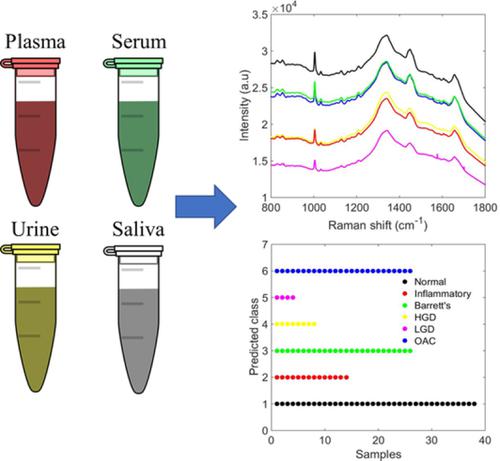当前位置:
X-MOL 学术
›
J. Biophotonics
›
论文详情
Our official English website, www.x-mol.net, welcomes your
feedback! (Note: you will need to create a separate account there.)
Raman spectral discrimination in human liquid biopsies of oesophageal transformation to adenocarcinoma.
Journal of Biophotonics ( IF 2.0 ) Pub Date : 2019-12-15 , DOI: 10.1002/jbio.201960132 Ishaan Maitra 1 , Camilo L M Morais 1 , Kássio M G Lima 1, 2 , Katherine M Ashton 3 , Ravindra S Date 3 , Francis L Martin 1
Journal of Biophotonics ( IF 2.0 ) Pub Date : 2019-12-15 , DOI: 10.1002/jbio.201960132 Ishaan Maitra 1 , Camilo L M Morais 1 , Kássio M G Lima 1, 2 , Katherine M Ashton 3 , Ravindra S Date 3 , Francis L Martin 1
Affiliation

|
The aim of this study was to determine whether Raman spectroscopy combined with chemometric analysis can be applied to interrogate biofluids (plasma, serum, saliva and urine) towards detecting oesophageal stages through to oesophageal adenocarcinoma [normal/squamous epithelium, inflammatory, Barrett's, low‐grade dysplasia, high‐grade dysplasia and oesophageal adenocarcinoma (OAC)]. The chemometric analysis of the spectral data was performed using principal component analysis, successive projections algorithm or genetic algorithm (GA) followed by quadratic discriminant analysis (QDA). The genetic algorithm quadratic discriminant analysis (GA‐QDA) model using a few selected wavenumbers for saliva and urine samples achieved 100% classification for all classes. For plasma and serum, the GA‐QDA model achieved excellent accuracy in all oesophageal stages (>90%). The main GA‐QDA features responsible for sample discrimination were: 1012 cm−1 (C─O stretching of ribose), 1336 cm−1 (Amide III and CH2 wagging vibrations from glycine backbone), 1450 cm−1 (methylene deformation) and 1660 cm−1 (Amide I). The results of this study are promising and support the concept that Raman on biofluids may become a useful and objective diagnostic tool to identify oesophageal disease stages from squamous epithelium to OAC.
中文翻译:

在人类食管活检中向腺癌的液体活检中的拉曼光谱鉴别。
这项研究的目的是确定拉曼光谱法与化学计量学分析相结合是否可用于探查生物流体(血浆,血清,唾液和尿液),以检测食道阶段直至食道腺癌[正常/鳞状上皮,炎性,巴雷特氏病,低-级不典型增生,高度不典型增生和食道腺癌]。使用主成分分析,连续投影算法或遗传算法(GA)进行光谱数据的化学计量分析,然后进行二次判别分析(QDA)。使用唾液和尿液样本的几个选定波数的遗传算法二次判别分析(GA-QDA)模型实现了所有类别的100%分类。对于血浆和血清,GA-QDA模型在所有食道阶段均达到了卓越的准确性(> 90%)。GA-QDA的主要特征是:1012 cm-1(核糖的C - O拉伸),1336 cm -1(来自甘氨酸骨架的酰胺III和CH 2摆动振动),1450 cm -1(亚甲基变形)和1660 cm -1(酰胺I)。这项研究的结果是有希望的,并支持拉曼生物流体可能成为一种有用的客观诊断工具,以鉴定从鳞状上皮到OAC的食道疾病阶段的概念。
更新日期:2019-12-15

中文翻译:

在人类食管活检中向腺癌的液体活检中的拉曼光谱鉴别。
这项研究的目的是确定拉曼光谱法与化学计量学分析相结合是否可用于探查生物流体(血浆,血清,唾液和尿液),以检测食道阶段直至食道腺癌[正常/鳞状上皮,炎性,巴雷特氏病,低-级不典型增生,高度不典型增生和食道腺癌]。使用主成分分析,连续投影算法或遗传算法(GA)进行光谱数据的化学计量分析,然后进行二次判别分析(QDA)。使用唾液和尿液样本的几个选定波数的遗传算法二次判别分析(GA-QDA)模型实现了所有类别的100%分类。对于血浆和血清,GA-QDA模型在所有食道阶段均达到了卓越的准确性(> 90%)。GA-QDA的主要特征是:1012 cm-1(核糖的C - O拉伸),1336 cm -1(来自甘氨酸骨架的酰胺III和CH 2摆动振动),1450 cm -1(亚甲基变形)和1660 cm -1(酰胺I)。这项研究的结果是有希望的,并支持拉曼生物流体可能成为一种有用的客观诊断工具,以鉴定从鳞状上皮到OAC的食道疾病阶段的概念。












































 京公网安备 11010802027423号
京公网安备 11010802027423号